Nicca Cameras 1942-1961
A Description of Nicca Cameras 1942-1961
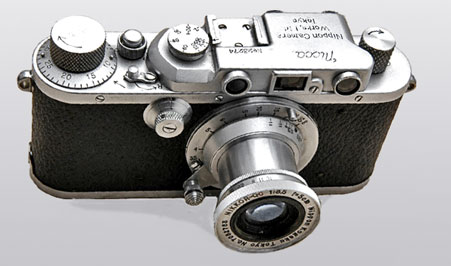
the Nicca 'Original' of 1948 with Nikkor 5cm f3.5 lens
History of the Nicca Camera
The Nicca Camera Co. Ltd. started as the optical workshop Kōgaku Seiki-sha 光学精機を or Optical Precision Equipment. The initial employees had come from Seiki-Kogaku Kenkyusho - the company which grew to manufacture Canon cameras. In creating the optical workshop Kōgaku Seiki-sha, the timing was not ideal, since Japan was already at war with China, and of course would soon be totally involved with World War II.
Creation of the 'Nippon' Camera
In August 1941 Kōgaku Seiki-sha received a commission from the Ministry of War for the construction of 35mm Leica-type M39 mount cameras. In spite of war-time conditions, Kōgaku Seiki-sha was able to produce its first cameras during 1942 to 1944. These were labeled "Nippon". It is said by Peter Dechert that only about ten units of this camera only were initially produced 27. Perry Tourtellotte communicated to me his possession of what seems to be one of these small number of initially produced Nippon cameras. The photograph of this very rare camera, probably produced in 1942 for the Imperial Japan military, is shown below. (thanks Perry !)
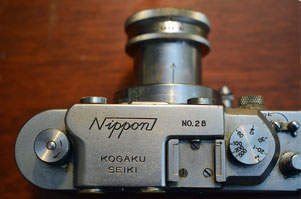
a very early Nicca 'Original'
Peter Dechert writes: "Somehow the group managed to maintain their identity during the 1941-1945 war. They even managed to complete as many, perhaps, as three hunder Nippon cameras, probably entirely for various Japanese military agencies. These cameras were of two standard sorts. The more versatile was based on the Leica III and resembled it in almost every major detail... the other was like a Leica Standard in function without slow speeds" 27

Nippon Model of 1944 or 1945 - what seems to have been the 122nd unit produced
Company Name Change to Nicca
In 1948, the company changed its name to the Nippon Camera Works - ニッポンカメラ Peter Dechert further wrote: "...they realized that the camera would sell more rapidly in the multi-national milieu gathered in reconstructive Japan if they called it something else [other than 'Nippon' which meant 'Japan']... Thus, Nippon became the Nicca, presumably a form of contraction of "Nippon Camera" and coincidentally one of the trade names that Nippon Kogaku had considered before settling on "Nikon". 27
In 1949, the company adopted the camera name to be their company name: the "Nicca Camera Works, Ltd." - using ニッカ
Nippon Camera of 1947
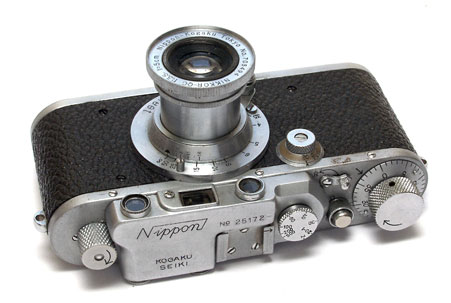
Nippon Model of 1947 or 1948
This example shown above seems not equipped with the original lens which ususally was a Xebec 5cm f2.0. camera-wiki.org wrote:
"The K.O.L. Xebec 5cm f/2 (serial numbers 34xxx, 66xxx, 70xxx, 75xxx, 77xxx) was the only lens made during World War II for the Nippon Leica copy."
This camera model, was first labeled with the brand name "Nippon".
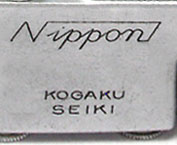
It was a near copy of the Leica III with separate rangefinder/viewfinder.
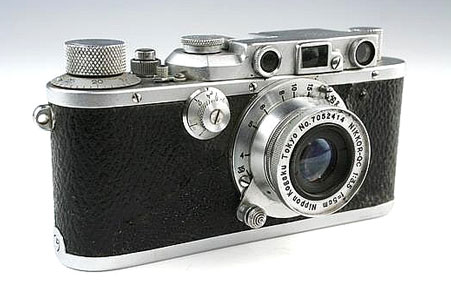
Later production models were labeled "Nicca" following the company name change, described above. With the camera serial number of this camera beginning with "23", this indicates a 1948 year of manufacture. The Shōwa era was the years of reign of the Emperor Hirohito, and Shōwa 23, the 23rd year was 1948.
Nicca Type-3
In 1950, with the company name now "Nicca Camera Works Ltd." and using ニッカ, the company produced the Nicca Type-3 in quantity - perhaps 4,000 units during 1950-1954.
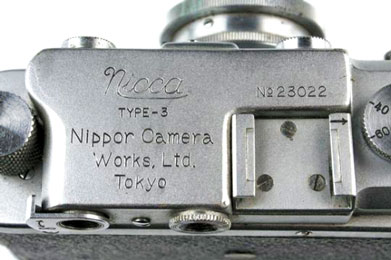
Nicca Type-3 camera top - the diopter adjustment lever can be seen on the back of the viewfinder port.
Nicca III-A and III-B
In mid-year 1951 5 Nicca introduced the Nicca III-A and III-B. These cameras were similar to the Nicca Type-3, except in September, 1951, the company identification on camera top became "Nicca Camera Company, Ltd." The two models differed in that the Nicca III-A had no flash synchronization, whereas the Nicca III-B had both M flash bulb synchronization and X electronic strobe flash synchronization via pins on the camera body front. Synchronization was at 1/20 second.
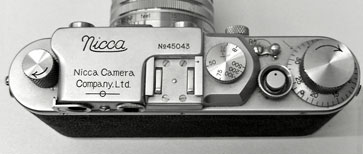
Nicca IIIA camera without flash synchronization
Nicca Agreement with Sears, Roebuck & Company
In 1950, Nicca was fortunate in gaining an agreement with Sears, Roebuck & Company to manufacture cameras with the Sears brand name "Tower". In 1950, Sears was the largest retailer in the United States, and was headquartered in the Sears Merchandise Building Tower (different from the later Sears Tower skyscraper in Chicago.)

a Tower Type-3 of 1951 based on the Nicca IIIA
Nicca continued to supply Sears with a series of Nicca rangefinders - a relationship which continued as long as Nicca produced cameras. 27

Sears camara catalogue of 1952
Nicca IIIS - later Nicca Type-IIIA
Nicca in 1952 introduced the Nicca IIIS, which was an inproved finish Nicca IIIB with M and X flash synchronization on the camera face, and new engraving on the camera top - "Nicca Camera Company, Ltd." and a film plane line.

Nicca IIIS
Serial numbers were 52xxx-58xxx and about 8000 units were produced between 1952-1954, making this a successful model for Nicca.
Nicca Type-4
The Nicca Type-4 camera was Nicca's first with a 1/25 second split between the low speed and high speed dials. This new higher speed of 1/25 second was also the synchronization speed for both flash bulb and electronic strobe flash units. This new shutter also featured a top speed of 1/1000 second for the first time. Nicca also added a film speed reminder to the tope of the film winding knob.

Nicca Type-4 of1954
Only about 1000 units of the Nicca Type-4 were sold during 1954-1955 with serial numbers in the 80xxx series. 5
Nicca 3-S
In February 1954, Nicca introduced the Nicca 3-S, which was essentially a Nicca Type-4, but without the top 1/1000 second speed and set at a lower selling price. This marketing strategy seems to have succeeded, since Nicca sold about 10,000 of these cameras in 1954 to 1956, with serial numbers 59xxx to 69xxx.
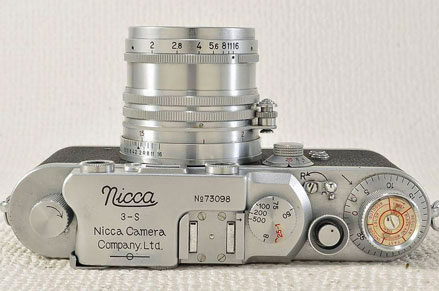
Nicca 3-S
Nicca Type-5
Nicca in 1955 slightly strengthened the Nicca Type-4 in the Type-5. The superstructure was expanded and came down to surround the lens mount on the front of the camera. It had a rangefinder and viewfinder similar to the Leica IIIf with the same 38mm base of its rangefinder as the IIIf. The rewind knob was surrounded by a release locking rewind. Also added was a locking catch on the slow speed dial. The film winding knob had a film speed reminder on top.

Nicca Type-5 of 1956
During 1955 and 1956, the Nicca Type-5 sold about 3,500 units with serial numbers 126xxx to 129xxx.
Sear Tower 45 and 46
Sears, Roebuck & Company sold the Nicca Type-5 with the Tower brand on the camera top as the Tower 45 and Tower 46. These two cameras were identical except that the Tower 45 was sold with a Nikkor 50mm f2.0 lens and the Tower 46 with a fast Nikkor 50mm f1.4 (the same lens as sold on the famous Nikon Model S2). The Tower 45 and 46 also had an important addition - a thumb lever winder for film advance, rather than the Nicca Type-5 knob film advance. This camera, with its 1-1000 top speed and Nikkor lenses was a most competitive offering, at a price about one half that of contemporary Canon and Nikon rangefinders.
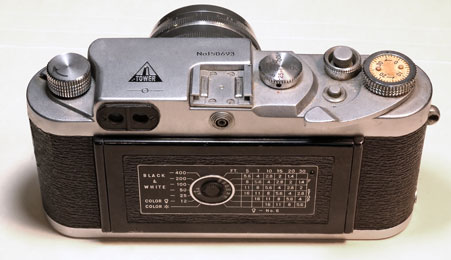
Tower 45 of 1956
Nicca 3-F
In October 1956, Nicca Cameras introduced the Nicca 3-F, similar to the Model-5. but
with a top shutter speed of 1/500 second. It was first introduced with a knob film
winder, but was then updated with the more popular lever winder. Peter Dechert wrote
that a small number of Model-5 cameras was also fitted with a lever winder near the
end of this production in 1956. 27

Nicca 3-F
The Nicca 3-F was produced in approximately 3,500 units with serial numbers 85xxx-97xxx in 1956 for the knob wind version and for the lever wind in 1957, serial numbers 150xxx to about 18xxxx.
Nicca Lenses
Nicca Camera Co. sold only one lens which was branded "Nicca". This was a 50mm f2.8 lens sold on the Nicca Type 33. This lens was not manufactured by Nicca, but by another Japanese vendor - Peter Dechert speculated that Sun Optical may have been the manufacturer. 27

Nicca 50mm f2.8
| Camera Name | Manufacturer | Production Years | Shutter | Flash Synchro | Qty | Note |
|---|---|---|---|---|---|---|
| Nippon | Kogaku Seiki | 1942-1944 | 1-20 Z, 20-500 | no | low | no slow speed lock |
| Nippon | Kogaku Seiki | 1943-1946 | 20-500 | no | low | No rangefinder, no slow speeds |

Nippon with no rangefinder, no slow speeds | ||||||
| Nippon 3 | Kogaku Seiki | 1946 | 1-20 Z, 20-500 | no | low | |
| Nippon Nicca Type-3 | Nippon Camera Works, Ltd. | 1948-1949 | 1-20 Z, 20-500 | no | 200-300 | |
| Nicca Original | Nicca Camera Works, Ltd. | 1948-1949 | 1-20 Z, 20-500 | no | 200 | no slow speed lock |
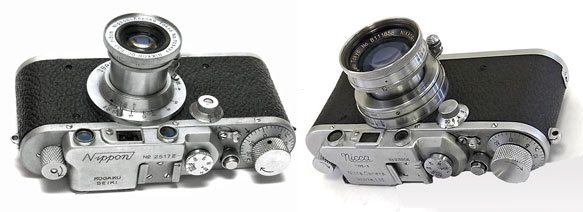
Nippon Original with Nikkor 5cm f3.5 and Nicca T-3with Nikkor f2.0 | ||||||
| Nicca Type-3 | Nippon Camera Works, Ltd. | 1949-1954 | 1-20 B or Z, 20-500 | no | 4000 | diopter adjustment, no slow speed lock |
| Nicca Type-IIIA | Nicca Camera Company, Ltd. | 1951-1952 | 1-20 B, 20-500 | no | 5000 | diopter adjustment, no slow speed lock |

Nicca IIIA with rigid Nikkor 5cm f2.0 with no flash synchronization | ||||||
| Nicca Type-IIIB | Nicca Camera Company, Ltd. | 1951-1952 | 1-20 B, 20-500 | bulb and flash on front | 3000 | diopter adjustment, no slow speed lock |
|
Nicca Type-IIIS Tower-3S | Nicca Camera Company, Ltd. | 1952-1954 | 1-20 B, 20-500 | bulb and flash on front | 6000 | diopter adjustment, no slow speed lock |

Nicca 3-S with Nikkor f2.0 and Type-IIIS with Nikkor f2.0 | ||||||
| Nicca 3-S | Nicca Camera Company, Ltd. | 1954-1956 | 1-25 B, 25-500 | bulb and flash on front | 10000 | no slow speed lock |
| Nicca Type-4 | Nicca Camera Company, Ltd. | 1954-1955 | 1-25 B, 25-1000 | bulb and flash on front | 1000 | knob advance, no slow speed lock |
| Nicca Type-5 | Nicca Camera Company, Ltd. | 1955-1956 | 1-25 B, 25-1000 | coaxial on back | 4000 | slow speed lock, door opening back on vertical hinge |

Nicca Type-4 and Type-5 top | ||||||
|
Nicca Type-5 Tower-5 | Nicca Camera Company, Ltd. | 1955-1956 | 1-25 B, 25-1000 | coaxial on back | 3500 | no diopter adjustment, slow speed lock, new one-piece top |
| Nicca 3-F knob | Nicca Camera Company, Ltd. | 1956-1957 | 1, 2, 5, 10, 15, 25 B, 25-500 | coaxial connector on back, synch at 1/25, no diopter adjustment | 4000 | slow speed lock, film type on winding knob |
| Nicca 3-F Lever | Nicca Camera Company, Ltd. | 1957-1958 | 1-25 B, 25-500 | no | 1500 | first Nicca lever winder, slow speed lock |
| Nicca Tower 45 w/Nikkor 50mm f2.0 | Nicca Camera Company, Ltd. | 1957-1958 | 1-25 B, 25-1000 | coaxial flash on back | 10000 | lever wind, door opening back on horizontal hinge, slow speed lock |
| Nicca Tower 46 w/Nikkor 50mm f1.4 | Nicca Camera Company, Ltd. | 1957-1958 | 1-25 B, 25-1000 | coaxial flash on back | 10000 | lever wind, door opening back on horizontal hinge, slow speed lock |
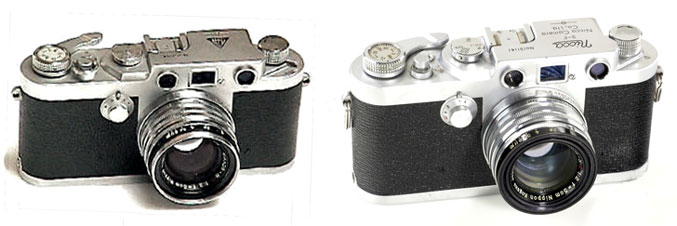
Nicca Tower 45 with Nikkor f2.0 and Nicca 3-F Lever with Nikkor f2.0 | ||||||
| Nicca 33 | Nicca Camera Company, Ltd. | 1958 | (no 1) 2-30 B, 30X, 60-500 | coaxial on back | 1000 | economy version, lever winder, black speed dials |
| Nicca 3L | NICCA | 1958-1959 | 1-25 B, 10-X, 25-1000 | coaxial connector on back | 2000 | lever winder,new body styling, new lever type, door opening back on horizontal hinge, projected frame finder |

economy Nicca 33 without 1 second speed and newly styled Nicca 3L with new style lever winder | ||||||
| Yashica YE | Yashica Company Ltd. | 1958-1960 | 1-500 | coaxial connector on back | 4000 | a rebranded Nicca 33, lever winder |
| Yashica YF | Yashica Company Ltd. | December 1958-1960 | 1-30 B, 30-1000 | coaxial connector on back | 7000 | combined viewfinder/rangefinder with 35mm view and 50mm, 100mm projected frames parallax corrected |
Yashica Acquires Nicca
In May 1958, Yashica Company, Ltd. as it was then known (previously 'Yashima Seiki Company'), acquired the Nicca Camera Company Ltd. (although the transaction took place in several steps over 1958-1960). Yashica had previously been primarily a manufacturer of leaf-shutter twin lens reflex cameras of the 6 X 6 cm medium format. The acquisition of Nicca provided them with expertise in focal-plane shutter construction and the 35mm camera format.
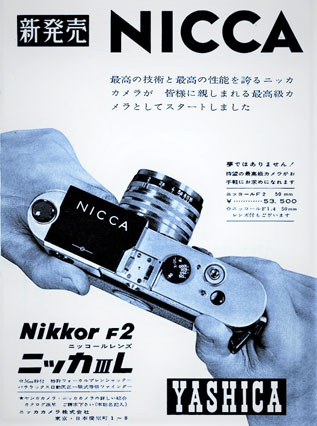
The Nicca connection to Yashica, following Nicca's acquisition shown in advertising of 1959. The initial Yashica rangefinder, the Yashica YE was primarily a re-badged Nicca 33.
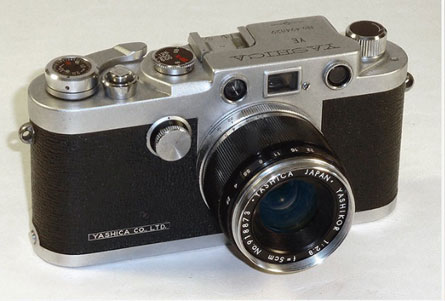
Yashica YE of 1953 with Yashinon 5cm f2.8 and "Yashica Co. Ltd." engraved on front.
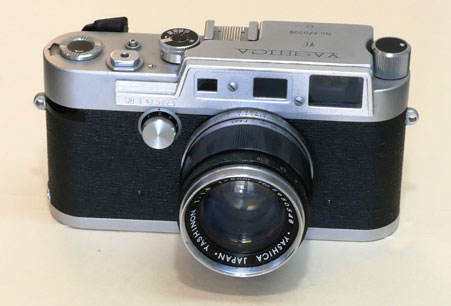
Yashica YF of 1959 with Yashinon 50mm f1.8 and "Nicca" also engraved on front
You can click on the links in the table below to consult other pages of the canonrangfinder.org site.
| Navigation: Click Below to Jump to Desired Subject Page | ||
|---|---|---|
| Canon Rangefinder Cameras - 1 | Canon Rangefinder Cameras - 2 | Canon Rangefinder Lenses |
| Canon Hansa | Canon IIAF, IIAX | Development Nikkor 50mm |
| Canon S | Canon IVSB2 | Canon 19mm |
| Canon J | Canon IIS2, IID2, IIF2 | Canon 25mm |
| Canon NS | Canon VT, Canon L2 | Canon 28mm |
| Canon JS | Canon L1, L3 | Canon 35mm |
| Canon S-I | Canon VT Deluxe | Canon 50mm |
| Canon J-II | Canon VL, VL2 | Canon 85mm |
| Canon S-II | Canon VI-L, VI-T | Canon 100mm |
| Canon IIB | Canon P | Canon 135mm |
| Canon III, IIC, IV | Canon 7 | Canon 200mm-1000mm |
| Canon IIIA, IVF, IVS | Canon 7s | Canon Accessories |
| Canon IIA, IID, IID1 | Nicca Rangefinders | Canon Finders |
| Canon IVSB | Leotax Rangefinders | Minolta Rangefinders |
| Canon IIF, IIS | Other Rangefinders | Minolta Lenses |
| Comparison Canon - Nikon Rangefinders | other M39 lenses | |
| Go to canonrangefinder.com home page | ||
Any additions or corrections to these pages would be welcome simply by contacting this site as shown at the foot of this page .
Footnotes:
1 Dechert, Peter. Canon Rangefinder Cameras 1933-1968. Hove Collectors Books. West Sussex, United Kingdom. 1985. ISBN 0-906447-30-5.
Peter Dechert's book is the most important expert source of information regarding Canon Rangefinder Cameras.
2 Kitchingman, Peter. Canon M39 Rangefinder Lenses 1939-1971. A Collector's Guide. Published by Peter Kitchingman. Perth, Australia. 2008. ISBN 978-0-646-48144-9.
Peter Kitchingman's book is the definitive study of the more than three decades of M39 format camera lenses developed for Canon Rangefinder Cameras.
3 Nostalgic Canon Camera Book. 懐かしいキヤノン EI Publishing Co. Ltd. Tokyo, Japan. June 2003.
Peter Kitchingman's book is the definitive study of the more than three decades of M39 format camera lenses developed for Canon Rangefinder Cameras.
4 "Canon Camera Museum" history website. https://global.canon/en/c-museum/history/ published by Canon, Inc. accessed in 2019.
5 Rajner, Hans P. (author), John Wade (editor). Leica Copies. Classic Collections Publications. London, UK. ISBN 13: 9781874485056
Hans P. Rajner's book is an excellently detailed and carefully researched study of camera from around the world which used the Leica M39 lens mount and the same lens to film plane distance.
7 Dechert, Peter. Canon Single Lens Reflex Cameras 1959-1991. Historical Camera Publications. Yakima, Washington. 1992. ISBN 1-879561-04-2.
8 Tomlinson, Shawn M. The Film Photography Book. Lulu Pulbications. 2016. ISBN: 9781365263972
9 Sartorius, Ghester. Identifying Leica Lenses. Classic Camera 19. Tokyo, Japan. 2001. ISBN 4-257-12029-0
10 website http://www.nicovandijk.net/rflensmatrix.htm consulted 2019.
11 O'Reagan, Douglas M. Allied Exploitation of German Science after World War II. Johns Hopkins University Press. Baltimore, Maryland. 2019. ISBN 9781421428888
12 website www.canonrangefinder.servehttp.com consulted 2008.
13 Minolta expert Andrea Aprà has posted information on minoltarangefinders group and other groups and further detailed information by email. (thanks Andrea !)
14 website http://www.collection-appareils.fr/objectifs/ consulted 2019.
15 Small, Marc James. Non-Leitz Leica Thread-Mount Lenses. Wittig Books. Hückelhoven, Germany. 1997. ISBN 3-930359-47-2.
16 the Nikon Corporation website: https://imaging.nikon.com/history/ consulted 2019.
17 p 152. Ray, Sidney F. Photographic Lens ISBN 9780240510323
18 website http://www.rokkorfiles.com/Lens%20History.html accessed 2019
19 Katz, Jerome. The Kardon camera story: a dedication to Peter Kardon, great American patriot & pioneer. SJF Enterprises. New York, New York. 1977.
20 Baird, John. The Japaneese Camera. The History of the Japanese Camera Monograph Collection. Historical Camera Publications. Yakima, Washington. 1990. ISBN 1-879561-02-6.
21 interesting website http://www.topgabacho.jp/Topconclub/Leotax.htm accessed 2019
22 Alexander, Jeffrey Scott. Nikon and the sponsorship of Japan's optical industry by the Imperial Japanese Navy 1923-1945. MA Thesis. University of British Columbia. 2001.
23 Alexander, Jeffrey Scott. Nikon and the sponsorship of Japan's optical industry by the Imperial Japanese Navy 1923-1945. PhD Thesis. University of British Columbia. 2010.
24 Lewis, Gordon, editor. Fujimura, Amy and Fujimura, William, translators. The History of the Japanese Camera. International Museum of Photography at George Eastman House. Tokyo and Rochester. 1991. ISBN 0-935398-17-1.
25 Rotoloni, Robert. Nikon Rangefinder Camera: An Illustrated History Hove Books Ltd. Sussex, UK. 1993. ISBN-13: 978-1874707073
26 Eastland, Jonathan. Dr. Leica M Compendium: Handbook of the Leica-M System Hove Books Ltd. Sussex, UK. 2006. ISBN-13: 9781897802052
27 Dechert, Peter. The Contax connection The Japanese Roots of the Recent Contax Cameras. Monograph Collection. Historical Camera Publications. Yakima, Washington. 1990.
If you have any comments or questions about this Canon Rangefinder site, please e-mail me (Larry Huffman) at e-mail address: [email protected]